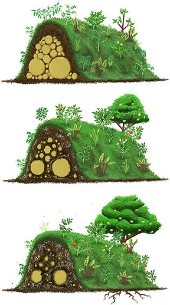Very true, Xisca. Each situation is different, and needs much observation. Here in the intermountain areas of the US, in the summer we look for shade, the more the better. My little piece of ground is flat, sandy, and has no trees. Shade is one of our first needs at my new garden spot, both to make the place endurable in the very intense high elevation summer sun, and to help other plants grow better with partial shade and shelter from the wind, mulch from the leaves, etc. So if I can get a bunch of trees, such as honey locust or siberian pea shrub, etc, to grow from seeds in the leaves I harvest in autumn, I will let them grow as thickly as they can, then thin them out to let the stronger, faster growing ones have more room. Eventually we will discover by observation how much room they need. I have seen a few clumps of trees, mostly the siberian elms that grow everywhere in the local towns, where each tree is only a few feet apart, but each one in the clump leans a different way to reach the light.
I have even seen pear trees growing like that in southern Utah, at about 5000 ft elevation, very tall trees, but they produced very good fruit. My son had to climb on the roof of the motel (with permission from the owner) to pick a bunch for us to slice and dehydrate for winter use. All the roots were growing close together, but they shared the mulch from their leaves, and it was easier to water and tend one bed, than to have 6 or 8 trees spread out 25 feet apart. And it made a nice shady area under the trees to sit and relax. To me, that is a permaculture solution, instead of thinking, orchard.
I planted my apples and plums at home in a similar way, with 2 trees in one planting hole, then the care and maintenance is all in one place. It works well, especially in a small urban or suburban or small town backyard. Then I planted my bush fruits and ground covers around the trees, so I only have to turn on the water system for a bed, with its guild of plants, instead of in rows as in an orchard, where each tree has to be tended individually.
You are right, though, about water, if there is a reserve of water in the soil. But in our sandy soil, I have not found that to be true. So now we usually dig out the sand, 18 inches to 2 feet deep, then fill the hole with cardboard, newspaper, woody wastes, spoiled hay, leaves,
compost, etc--whatever I can get, and plant in that. I have found it is much easier to spread mulch on a guilded garden, in a bed, than to collect enough mulch for each individual tree or plant. And, the winds here blow so fiercely that I have gone out after a strong gust of wind to find that all my carefully laid mulches have blown away, "somewhere over the rainbow." But with the guilds, there is usually enough plant growth to keep the mulch from disappearing, and the trees and shrubs etc all help mulch each other, so they don't actually need as much added water as they would if each was planted alone. We tried some 'spot' planting 2 years ago, with holes dug every 4-5 feet, filled with compost, and planted to corn or squash, etc, to "give each plant more room to spread its roots" according to some book I read. There was no rain to speak of, and it was impossible to water enough to keep the compost holes damp. Some corn plants did grow--to about 1 foot high before they tassled, but of course, no corn. trees would be the same, I think, so now I plant everything in larger beds, that I can prepare, mulch, water, etc as a unit. I have found that works much better in this high and dry area.





















 1
1












 3
3








 1
1
















